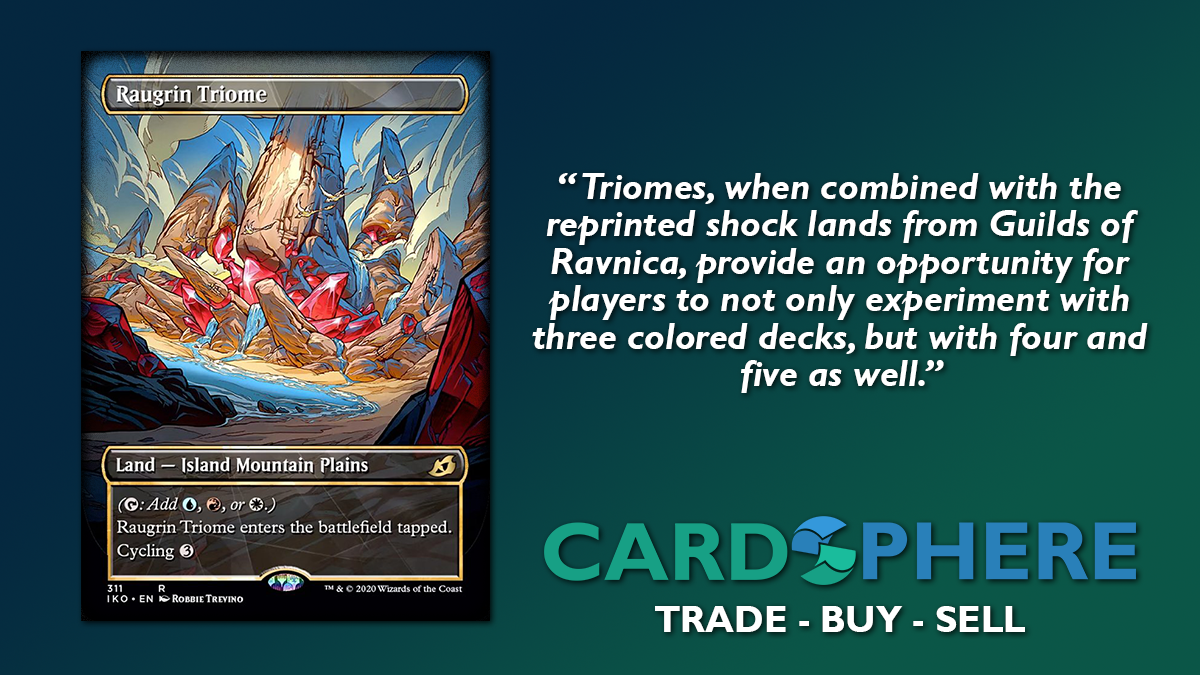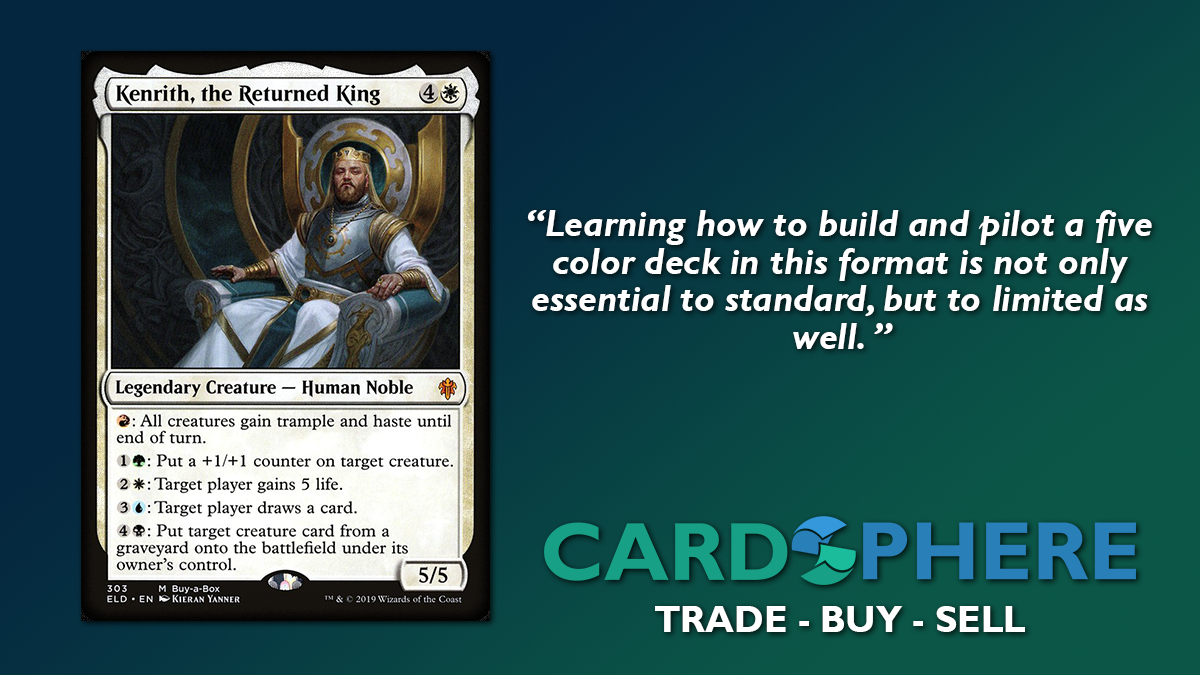5 Color Decks: Taking the Plunge for Growth

When I started playing Magic the Gathering in 2011, I played in the Innistrad prerelease at my local game store while in graduate school. Immediately after receiving my sealed pool, I remember feeling stressed out about playing anything other than a mono colored deck. At the time, the Paris Mulligan was active. For those who would like a refresher, the Paris Mulligan provided the option to mulligan regardless of the contents of the starting hand, but the player must take one card less. Since I was afraid to play more than one color, as well as starting with a five card hand because I lacked sufficient mana sources, I decided to play black with a splash of green. While I did well overall at my first event, I also hindered my ability to grow as a player through not understanding mana ratios and fixing - abilities that are essential to becoming a better player.

The next opportunity to try a multi-colored deck occurred during the Khans of Tarkir block. During this time, I decided to exclusively play limited. While Khans was a pleasure to draft, I had some issues early on concerning the power level of the decks I was creating. In the Return to Ravnica block, I gradually became used to playing dual colored decks, which was facilitated by the reprint of shock lands. In Khans draft, there were common dual lands and even uncommon tri lands, but I would only play tricolored decks if I had a good reason to do so, such as a powerful rare or mythic card. While I did win first in some drafts, I began to wonder if I was holding myself back because I would not typically play decks with more than two colors.
At the end of 2019, I reflected on my gameplay as I had finished my first year of playing MTG on an esports team (OXG Esports, formerly known as Team Genji). I played in two Mythic Championships, and noticed that I had never seemed to want to play more than two colors even after almost ten years of playing MTG. The most successful deck I had played involved a combo with Runaway Steam-Kin and Experimental Frenzy - a mono red deck. With the introduction of Fires of Invention, I began playing my first tricolor standard deck: Jeskai Fires. However, I am sure many would perceive playing Jeskai Fires as cheating in terms of playing a multicolored deck. One of my criticisms of the first few installments of Jeskai Fires (prior to Ikoria: Lair of Behemoths) is that the deck was too reliant on Fires of Invention to win the game. Once more, I relied on mono red and Embercleave to get me through much of the Throne of Eldraine and Theros Beyond Death sets.
With the introduction of Ikoria: Lair of Behemoths, as well as the new companions mechanic along with it, the standard meta forced players to find the greatest amount of value in cards possible. While players should strive to look for value in terms of board state, the addition of a possible eighth card to the starting hand provides motivation for players to look for synergy and value more than ever. The lack of a companion presents dire consequences for players that choose not to play them. One enormous consequence, for example, of not playing companions is to sacrifice consistency.

However, while not the primary focus of the set, Ikoria presented another opportunity for players to try out multicolored decks in a big way: Triomes. Triomes, when combined with the reprinted shock lands from Guilds of Ravnica, provide an opportunity for players to not only experiment with three colored decks, but with four and five as well. Also, the inclusion of Paradise Druid, Gilded Goose, and Arboreal Grazer provide a comfortable way to begin the first few turns. This multitude of dual and tri colored mana, mana creatures, combined with the London Mulligan, which enables players to draw a new hand of seven before putting cards back to the bottom of the deck proportional to the amount of times the player mulligans, creates a standard environment where a multitude of color combinations are possible. Brewing a multicolored deck during this time and having more access to the best those colors have available in their respective pools are needed in a time where Agent of Treachery no longer appears on turn 6 or 7, but as early as turn four or five against certain decks such as Jeskai Lukka Fires.
One of the best parts of Magic is truly "The Gathering." Even though the current climate does not allow for people to assemble in person and brew, thanks to MTG Arena and voice chat clients, the brewing process is still possible. A fellow competitor and friend I met on the ladder and Twitch, Red Destruction approached me with a fun five-colored deck. At first, the deck looked really difficult to pilot, even after so many years of MTG experience. For about five to six hours the next afternoon, Red and I were in a group call, testing all sorts of matchups, mulligans, and scenarios. Towards the end of the session, not only did I have a better grapple on the deck, but on how to pilot a multicolored deck in standard in general.
Winota Niv by Red Destruction (twitch.tv/reddestruction)
4 Agent of Treachery
4 Arboreal Grazer
4 Breeding Pool
4 Gilded Goose
4 Gruul Spellbreaker
2 Haktos the Unscarred
2 Judith, the Scourge Diva
2 Kenrith, the Returned King
3 Ketria Triome
3 Niv-Mizzet Reborn
4 Overgrown Tomb
4 Paradise Druid
4 Raugrin Triome
4 Savai Triome
4 Stomping Ground
4 Temple Garden
4 Winota, Joiner of Forces
SIDEBOARD:
3 Deafening Clarion
3 Deputy of Detention
2 General Kudro of Drannith
3 Knight of Autumn
3 Shifting Ceratops
1 Umori, the CollectorThe deck itself is a five colored Niv-Mizzet deck, with Niv-Mizzet Reborn, Winota, Joiner of Forces, and Agent of Treachery serving as the key cards. While Umori, The Collector is not necessary, as stated previously, it never hurts to have the eighth card in the opener as a form of consistency. The deck can function without both Niv and Winota as long as Haktos the Unscarred, Kenrith, The Returned King, and Agent of Treachery show up to the party. Umori makes both Kenrith and Agent cheaper and key in nearly every match. One of the best features of the deck is that it does not require one key card to win the game, and provides some of the best cards of the format (as well as some sleepers such as Haktos) because the player has access to all five colors.

While this standard is challenging for some and borders on frustrating for others, one way to provide a fresh perspective to the format is to play a four to five color deck. Learning how to build and pilot a five color deck in this format is not only essential to standard, but to limited as well. One of the most successful Ikoria limited decks I have built to date is solidly a four color deck. With Historic emerging as one of the more popular formats due to its established presence on MTG Arena and in future competitions, the possibilities are endless in deck construction. I challenge everyone to find a format that they enjoy, and build a multicolored deck. Positive results can be experienced in any format, and having access to the best of the best in every color is exciting, educational, and enlightening.
Challenge yourself, and get out of your comfort zone. Game on
